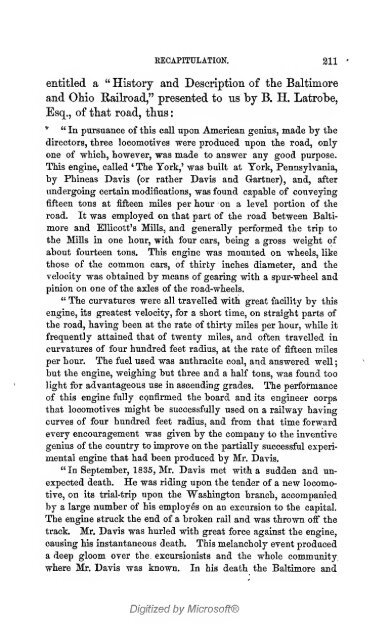The history of the first locomotives in America. From original ...
The history of the first locomotives in America. From original ...
The history of the first locomotives in America. From original ...
You also want an ePaper? Increase the reach of your titles
YUMPU automatically turns print PDFs into web optimized ePapers that Google loves.
RECAPITULATION. 311<br />
entitled a " History and Description <strong>of</strong> <strong>the</strong> Baltimore<br />
and Ohio Raiboad," presented to us loj B. H. Latrolae,<br />
Esq., <strong>of</strong> that road, thus<br />
:<br />
* " In pursuance <strong>of</strong> this call upon <strong>America</strong>n genius, made by <strong>the</strong><br />
directors, three <strong>locomotives</strong> were produced upon <strong>the</strong> road, only<br />
one <strong>of</strong> which, however, was made to answer any good purpose.<br />
This eng<strong>in</strong>e, called ' <strong>The</strong> Tork,' was built at York, Pennsylvania,<br />
by Ph<strong>in</strong>eas Davis (or ra<strong>the</strong>r Davis and Gartner), and, after<br />
undergo<strong>in</strong>g certa<strong>in</strong> modifications, was found capable <strong>of</strong> convey<strong>in</strong>g<br />
fifteen tons at fifteen mUes per hour on a level portion <strong>of</strong> <strong>the</strong><br />
road. It was employed on that part <strong>of</strong> <strong>the</strong> road between Baltimore<br />
and Ellicott's Mills, and generally performed <strong>the</strong> trip to<br />
<strong>the</strong> Mills <strong>in</strong> one hour, with four cars, be<strong>in</strong>g a gross weight <strong>of</strong><br />
about fourteen tons. This eng<strong>in</strong>e was mounted on wheels, like<br />
those <strong>of</strong> <strong>the</strong> common cars, <strong>of</strong> thirty <strong>in</strong>ches diameter, and <strong>the</strong><br />
velocity was obta<strong>in</strong>ed by means <strong>of</strong> gear<strong>in</strong>g with a spur-wheel and<br />
p<strong>in</strong>ion on one <strong>of</strong> <strong>the</strong> axles <strong>of</strong> <strong>the</strong> road-wheels.<br />
" <strong>The</strong> curvatures were all travelled with great facility by this<br />
eng<strong>in</strong>e, its greatest velocity, for a short time, on straight parts <strong>of</strong><br />
<strong>the</strong> road, hav<strong>in</strong>g been at <strong>the</strong> rate <strong>of</strong> thirty miles per bour, while it<br />
frequently atta<strong>in</strong>ed that <strong>of</strong> twenty miles, and <strong>of</strong>ten travelled <strong>in</strong><br />
curvatures <strong>of</strong> four hundred feet radius, at <strong>the</strong> rate <strong>of</strong> fifteen miles<br />
per hour. <strong>The</strong> fuel used was anthracite coal, and answered well<br />
but <strong>the</strong> eng<strong>in</strong>e, weigh<strong>in</strong>g but three and a half tons, was found too<br />
light for advantageous use <strong>in</strong> ascend<strong>in</strong>g grades. <strong>The</strong> perfoi"mance<br />
<strong>of</strong> this eng<strong>in</strong>e fully confirmed <strong>the</strong> board and its eng<strong>in</strong>eer corps<br />
that <strong>locomotives</strong> might be successfully used on a railway hav<strong>in</strong>g<br />
curves <strong>of</strong> four hundred feet radius, and from that time forward<br />
every encouragement was given by <strong>the</strong> company to <strong>the</strong> <strong>in</strong>ventive<br />
genius <strong>of</strong> <strong>the</strong> country to improve on <strong>the</strong> partially successful experimental<br />
eng<strong>in</strong>e that had been produced by Mr. Davis.<br />
"In September, 1835, Mr. Davis met with a sudden and un-<br />
expected death. He was rid<strong>in</strong>g upon <strong>the</strong> tender <strong>of</strong> a new locomo-<br />
tive, on its trial-trip upon <strong>the</strong> Wash<strong>in</strong>gton branch, accompaiiied<br />
by a large number <strong>of</strong> his employes on an excursion to <strong>the</strong> capital.<br />
<strong>The</strong> eng<strong>in</strong>e struck <strong>the</strong> end <strong>of</strong> a broken rail and was thrown <strong>of</strong>f <strong>the</strong><br />
track. Mr, Davis was hurled with great force aga<strong>in</strong>st <strong>the</strong> eng<strong>in</strong>e,<br />
caus<strong>in</strong>g Ms <strong>in</strong>stantaneous death. This melancholy event produced<br />
a deep gloom over <strong>the</strong>, excursionists and <strong>the</strong> whole community,<br />
where Mr. Davis was known. In his death <strong>the</strong> Baltimore and<br />
Digitized by Micros<strong>of</strong>t®<br />
;
















